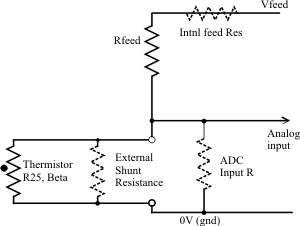Thermistors: Overview, theory
There are two broad types of thermistors: PTC (positive temperature coefficient) and NTC (negative temperature coefficient). For temperature measurement we use NTC thermistors. (PTC thermistors are not generally suitable for measuring temperature.)
An NTC thermistor consists of a small pellet of a special semiconductor material with two connecting wires.They can come in a number of different packages, ranging from a bare bead with two wires through to stainless steel probes or other complicated mountings.
NTC thermistors exhibit a resistance that decreases with increasing temperature.
Thermistors have a number of advantages over other electrical temperature sensors:
+ Low cost. A basic bead thermistor can be bought for well under a dollar in modest quantities.
+ High sensitivity. Thermistors produce a very large change in resistance with changing temperature. The result of this is that they can be used with very simple circuitry.
+ High accuracy. Contrary to popular belief, thermistors can be very accurate. 1°C is fairly standard, and units with 0.05°C accuracy are available for around $5 US (as a bare bead device).
+ Simple interface circuitry. Thermistors can be interfaced into a controller very simply. That is why we are able to include thermistor interfacing on our standard products at a trivial incremental cost (one resistor and one link - it costs us more to document it!). BY comparison RTDs and thermocouples require very expensive chips to interface them into a microprocessor.
Naturally, thermistors have some disadvantages. The most significant are:
- Limited temperature range. Typically, thermistors are usable only up to 150-200°C. There are, however, devices available that go as high as 750°C.
- Non-linear. Thermistors are highly non-linear. That means some arithmetic is required to produce a linear reading in degrees. Fortunately, SPLat can do the necessary calculations, so it is not so bad after all.
- No standardization. Whereas the main competing technologies, RTDs and thermocouples, are made in standardized and interchangeable types, thermistors tend to vary a lot from unit to unit and manufacturer to manufacturer. Several manufacturers do now make 'interchangeable' products, meaning units with closely defined and guaranteed characteristics.

The diagram above shows the generalised temperature measurement circuit implemented on a number of SPLat products. Ignore, for now, the components drawn in a dashed line.
In essence, the thermistor is connected to a fixed value resistor to form a simple voltage divider, with the thermistor as the bottom leg of the divider. The divider is driven from a voltage source called Vfeed. The voltage developed across the thermistor depends on the temperature. As the temperature of the thermistor increase its resistance drops and the voltage across it decreases. This voltage is measured by an analog input on the SPLat board to produce a number. The higher the temperature the smaller the number. By performing some sums on that number we can calculate the temperature.
Just about everything in this diagram can vary, between SPLat types, between applications and between thermistor types. However, by following the instructions provided later, and using the spreadsheet we provide you, the process is quite simple.
The components drawn in dashed line exist only in certain configurations. The spreadsheet makes allowance for them.
Because the thermistor is non-linear (its resistance change from say 25°C to 30°C is not the same as its resistance change from say 75°C to 80°C), the sums we do in the SPLat program must compensate for the nonlinearity. The calculation required uses a polynomial equation. This polynomial equation is generated automatically by the spreadsheet.
